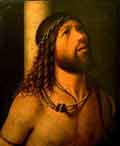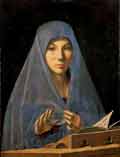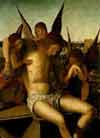 Antonello da Messina was bornin Messina between 1425 and 1430.
Antonello da Messina was bornin Messina between 1425 and 1430.
He trained with Colantonio in Naples during the reign of Alfonso I. This king welcomed artists from all over Europe and especially from the Flanders region. Antonio da Messina was one of southern Italy’s greatest Renaissance painters and representatives of Flemish painting in Italy. He travelled often to Venice, Milan, Rome and to the FrenchProvence region.
He lived in Messina from 1460 to 1465. The style of the pictures painted in these years shows typically Flemish and Provencal elements. Examples are Saint Jerome penitent (National Museum of Reggio Calabria) and Portrait of a Man (Museum of Cefalù).
He left Messina and travelled for 5 years to learn more and train. An important painting dating to this period is Salvator Mundi (currently in London) which clearly shows Antonio was acquainted with the work of Piero della Francesca (volume and geometrical simplification of shapes, even if colours are typically Flemish). A perfect merge of the Flemish taste for unusual elements and the spatial setting typical of Piero della Francesca is the Madonna with Child(Washington National Gallery).
When he returned to Messina Antonello started working again and painted St Gregory’s Polyptich (Museum of Messina), the Assumption (which currently needs to be restored) and St Jerome in His Study. One of Antonio’s most famous paintings is the Annunciation. Apparently it was painted after the 1475 journey to  Venice (where he painted a St Sebastian, possibly part of the triptych of St Rocco in the church of St Giuliano). He also painted the St Cassiano Altarpiece, currently in Vienna, which was a model for other artists who painted the same subject. The Pietà in the Correr Museum of Venice seems to be the final result of his study of light and shadows (the body of Christ appears thanks to light whereas there is darkness in the background).
Venice (where he painted a St Sebastian, possibly part of the triptych of St Rocco in the church of St Giuliano). He also painted the St Cassiano Altarpiece, currently in Vienna, which was a model for other artists who painted the same subject. The Pietà in the Correr Museum of Venice seems to be the final result of his study of light and shadows (the body of Christ appears thanks to light whereas there is darkness in the background).
He returned to Messina in 1476 and died there three years later.